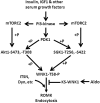Activation of PI3-kinase stimulates endocytosis of ROMK via Akt1/SGK1-dependent phosphorylation of WNK1
- PMID: 21355052
- PMCID: PMC3060440
- DOI: 10.1681/ASN.2010060681
Activation of PI3-kinase stimulates endocytosis of ROMK via Akt1/SGK1-dependent phosphorylation of WNK1
Abstract
WNK kinases stimulate endocytosis of ROMK channels to regulate renal K+ handling. Phosphatidylinositol 3-kinase (PI3K)-activating hormones, such as insulin and IGF 1, phosphorylate WNK1, but how this affects the regulation of ROMK abundance is unknown. Here, serum starvation of ROMK-transfected HEK cells led to an increase of ROMK current density; subsequent addition of insulin or IGF1 inhibited ROMK currents in a PI3K-dependent manner. Serum and insulin also increased phosphorylation of the downstream kinases Akt1 and SGK1 as well as WNK1. A biotinylation assay suggested that insulin and IGF1 inhibit ROMK by enhancing its endocytosis, a process that WNK1 may mediate. Knockdown of WNK1 with siRNA or expression of a phospho-deficient WNK1 mutant (T58A) both prevented insulin-induced inhibition of ROMK currents, suggesting that phosphorylation at Threonine-58 of WNK1 is important to mediate the inhibition of ROMK by PI3K-activating hormones or growth factors. In vitro and in vivo kinase assays supported the notion that Akt1 and SGK1 can phosphorylate WNK1 at this site, and we established that Akt1 and SGK1 synergistically inhibit ROMK through WNK1. We used dominant-negative intersectin and dynamin constructs to show that SGK1-mediated phosphorylation of WNK1 inhibits ROMK by promoting its endocytosis. Taken together, these results suggest that PI3K-activating hormones inhibit ROMK by enhancing its endocytosis via a mechanism that involves phosphorylation of WNK1 by Akt1 and SGK1.
Figures








Similar articles
-
Antagonistic regulation of ROMK by long and kidney-specific WNK1 isoforms.Proc Natl Acad Sci U S A. 2006 Jan 31;103(5):1615-20. doi: 10.1073/pnas.0510609103. Epub 2006 Jan 20. Proc Natl Acad Sci U S A. 2006. PMID: 16428287 Free PMC article.
-
WNK1 activates SGK1 by a phosphatidylinositol 3-kinase-dependent and non-catalytic mechanism.J Biol Chem. 2005 Oct 7;280(40):34218-23. doi: 10.1074/jbc.M505735200. Epub 2005 Aug 4. J Biol Chem. 2005. PMID: 16081417
-
Src family protein tyrosine kinase (PTK) modulates the effect of SGK1 and WNK4 on ROMK channels.Proc Natl Acad Sci U S A. 2009 Sep 1;106(35):15061-6. doi: 10.1073/pnas.0907855106. Epub 2009 Aug 18. Proc Natl Acad Sci U S A. 2009. PMID: 19706464 Free PMC article.
-
Roles of Akt and SGK1 in the Regulation of Renal Tubular Transport.Biomed Res Int. 2015;2015:971697. doi: 10.1155/2015/971697. Epub 2015 Sep 28. Biomed Res Int. 2015. PMID: 26491696 Free PMC article. Review.
-
Regulation and function of potassium channels in aldosterone-sensitive distal nephron.Curr Opin Nephrol Hypertens. 2010 Sep;19(5):463-70. doi: 10.1097/MNH.0b013e32833c34ec. Curr Opin Nephrol Hypertens. 2010. PMID: 20601877 Free PMC article. Review.
Cited by
-
Prognostic and Clinical Implications of WNK Lysine Deficient Protein Kinase 1 Expression in Patients With Hepatocellular Carcinoma.In Vivo. 2020 Sep-Oct;34(5):2631-2640. doi: 10.21873/invivo.12081. In Vivo. 2020. PMID: 32871793 Free PMC article.
-
WNK1 kinase is essential for insulin-stimulated GLUT4 trafficking in skeletal muscle.FEBS Open Bio. 2018 Oct 5;8(11):1866-1874. doi: 10.1002/2211-5463.12528. eCollection 2018 Nov. FEBS Open Bio. 2018. PMID: 30410865 Free PMC article.
-
Emerging Targets of Diuretic Therapy.Clin Pharmacol Ther. 2017 Sep;102(3):420-435. doi: 10.1002/cpt.754. Epub 2017 Jul 10. Clin Pharmacol Ther. 2017. PMID: 28560800 Free PMC article. Review.
-
Kinase Interaction Network Expands Functional and Disease Roles of Human Kinases.Mol Cell. 2020 Aug 6;79(3):504-520.e9. doi: 10.1016/j.molcel.2020.07.001. Epub 2020 Jul 23. Mol Cell. 2020. PMID: 32707033 Free PMC article.
-
Multistep regulation of autophagy by WNK1.Proc Natl Acad Sci U S A. 2016 Dec 13;113(50):14342-14347. doi: 10.1073/pnas.1617649113. Epub 2016 Nov 28. Proc Natl Acad Sci U S A. 2016. PMID: 27911840 Free PMC article.
References
-
- Ho K, Nichols CG, Lederer WJ, Lytton J, Vassilev PM, Kanazirska MV, Hebert SC: Cloning and expression of an inwardly rectifying ATP-regulated potassium channel. Nature 362: 31–38, 1993 - PubMed
-
- Zeng WZ, Babich V, Ortega B, Quigley R, White SJ, Welling PA, Huang CL: Evidence for endocytosis of ROMK potassium channel via clathrin-coated vesicles. Am J Physiol Renal Physiol 283: F630–F639, 2002 - PubMed
-
- Xu B, English JM, Wilsbacher JL, Stippec S, Goldsmith EJ, Cobb MH: WNK1, a novel mammalian serine/threonine protein kinase lacking the catalytic lysine in subdomain II. J Biol Chem 275: 16795–16801, 2000 - PubMed
-
- Wilson FH, Disse-Nicode‘me S, Choate KA, Ishikawa K, Nelson-Williams C, Desitter I, Gunel M, Milford DV, Lipkin GW, Achard JM, Feely MP, Dussol B, Berland Y, Unwin RJ, Mayan H, Simon DB, Farfel Z, Jeunemaitre X, Lifton RP: Human hypertension caused by mutations in WNK kinases. Science 293: 1107–1112, 2001 - PubMed
Publication types
MeSH terms
Substances
Grants and funding
LinkOut - more resources
Full Text Sources
Molecular Biology Databases
Miscellaneous

